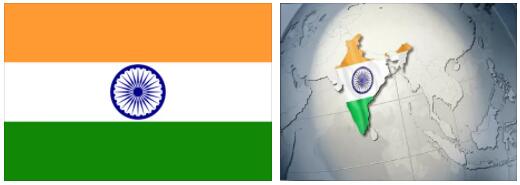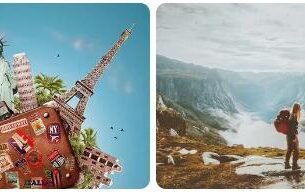Shopping
Overview
The traditions and methods of Indian handicrafts have been passed down from generation to generation for centuries and have been perfected as a result. Each region has its own specialty and each city has its own artisans with particular dexterity. Silks, spices, jewelery and many other typical Indian goods are world famous. Bargaining is common, except at State Emporiums and a few other fixed-price stores. State Emporiums are the state’s arts and crafts stores whose established prices are intended to benefit artisans. Textiles: Fabric manufacturing is one of the most important industries; Indian silks, cotton fabrics and wool fibers are among the best in the world. Among the silk fabrics, brocade from Varanasi is the best known, with other variations coming from Patna, Murshidabad, Kanchipuram and Surat. Colorful batik cotton fabrics are produced in Rajasthan, while Chennai is known for a fabric where the colors blend after a few washes, which is appreciated as a special effect. The Himroo cloth, a mixture of silk and cotton, is made nationwide. Cashmere wool is probably India’s best-known export product. Carpets: India’s carpet industry is also one of the largest in the world and many examples of this ancient and beautiful craft are on display in museums. Kashmiri carpets show patterns of Persian origin, are made of pure wool, cotton yarn or silk, are exceptionally exquisite and very expensive. Darjeeling is home to the distinctive colorful Tibetan runners. Clothing is very inexpensive and can be made to measure or changed in many shops within a short period of time if desired. Dresses are made of silk, himroo, cotton, brocade, chiffon and chinos. Rajasthani clothing is colorful and studded with innumerable small mirrors; bags, hats and money belts can also be found in this style. Jewelery is rich in tradition, heavy (especially from Rajasthan) and extremely diverse. Indian silverware is world famous. Gemstones can be processed directly at the place of purchase. Besides diamonds, there are lapis lazuli, rubies, sapphires, moonstones and aquamarines. Hyderabad is one of the world centers for pearls. Indian women and girls often wear a large number of bracelets made of silver, colored glass or plastic, which can be bought in every market in an amazing variety of colors and sizes. Arts and crafts and leather goods: Here, too, each region has its own speciality. Works are available in bronze, brass (often inlaid with silver), wattle and daub and ceramics. Kashmir is known for the artistic processing of papier-mâché; the finished products are often decorated with gold leaf. Agra’s specialty is marble and alabaster inlays in chess sets and ornamental plates. Indian leather goods such as sandals and slippers are of excellent quality. Wooden articles: Statues, caskets, bowls and other objects made of sandalwood are made in Karnataka, rosewood in Kerala and Chennai, Indian walnut in Kashmir. Other specialties: chutneys, spices and teas; perfume, soaps, handmade paper, Playing cards from Odisha and musical instruments. Shop opening hours: Mon-Sat 09.30-18.00 in the big shops.
- Searchforpublicschools: Offers schooling information of India in each level – compulsory, technical and higher education programs.
Nightlife
Introduction
Western nightlife is hard to find in India, with only a few big cities having nightclubs and discos. Cultural events with performances of Indian dance and music are the usual highlights. Mumbai and Kolkata (formerly Calcutta) are the metropolises of the Indian film industry (also called Bollywood. The name comes from the abbreviation Bombay Hollywood), the number of feature films produced is three times as high as in the USA. Almost every town has at least one cinema, some sometimes showing films in English. Music and dance, romantic dramas and politics play a major role in Indian film art, along with other influences. In large cities, theaters often stage plays in English. Bar and nightclub hours vary from state to state. In the state of Kerala, bars and nightclubs stay open until 11:00 p.m. Bars and nightclubs in Kerala are not allowed to serve hard alcohol, only beer and wine.
Accommodation
Hotels
Modern hotels of international standing can be found in all major cities and resorts. In general, first class European and Indian cuisine is offered. The well-known hotel chain Taj Group offers first-class accommodation in its 8 luxury hotels as well as in its various well-appointed business hotels. Some so-called palace hotels as well as leisure facilities in breathtaking scenery and hotels in regions of cultural importance also belong to this international chain. Prices are low compared to many other countries. Mostly 10% service and 7-15% luxury tax will be charged.
Camping
Addresses of Boy Scout campsites from the General Secretary for India, All India Boy Scouts Association. Information on Bharat (also Scouts) campsites from the National Secretary, Bharat Scouts & Guides.
Other accommodation options
Are practical and inexpensive bases for organized tours, for hiking and mountaineering. The Ministry of Tourism’s 20 or so hostels are spread across all regions and are ideally located for exploring both the lowlands and hill stations (the best places to relax during the hot summer months). Each hostel has around 40 beds in separate dormitories. Mattresses, bed linen, blankets, lockable cupboards, sockets, communal kitchens and parking spaces are available. For more information, please contact the Youth Hostels Association of India, 5 Nyaya Marg, Chanakyapuri, IN-New Delhi 110021. (Tel: (11) 26 11 02 50. Internet: www.yhaindia.org).
Culture
Religion
80.5% Hindu, 13.4% Muslim (8% Sunni, 3% Shia), 2.3% Christian, 1.9% Sikh, 0.9% Buddhist and other faiths.
Social Rules of Conduct
Manners: In India, on formal occasions, one greets one another with clasped hands over which one bows the head and says Namaste. It is unseemly for Indian women to shake hands in greeting. As a sign of respect, the feet of older people are touched in greeting. Upon entering sacred sites, one is asked to remove one’s shoes. Most Indians also remove their shoes before entering their homes. Most areas eat by hand, using only the right hand. Strict codes of conduct that have been in place for a long time still regulate religious and social occasions in many places today. Numerous Hindus are vegetarians and many, especially women, do not drink alcohol. Sikhs and Parsis do not smoke. It is important to observe these customs. Small gifts in recognition of the hospitality offered are appropriate. Women should dress modestly, short or very tight dresses should be avoided, they only attract unwelcome attention. There are trained English speaking guides in all tourist areas, some also speak German, French, Italian, Spanish, Russian or Japanese. The fees are fixed, the regional tourist office is happy to provide information. Official tourist guides have a permit from the Ministry of Tourism. Certain protected sights may not be entered by unofficial tourist guides. Photography: There are restrictions to protect some attractions and national parks. Permissions for the use of flash and tripod in certain buildings are issued by the Archaeological Survey of India, New Delhi. A fee is charged in conservation parks. Bridges and military installations are usually not allowed to be photographed, and cameras are officially not welcome at train stations either. Photography is not permitted in tribal areas. More information from the tourist offices. Smoking: Smoking in public places such as public transport, hospitals, cinemas, restaurants, bars, hotels, parks, shopping malls, etc. is prohibited in India. The possession and use of e-cigarettes is strictly prohibited in India. Tipping: It is customary to tip porters, waiters, maids and tour guides. In hotels and better restaurants, tips are usually included in the bill. A small, additional tip is still expected there. In restaurants where the tip is not already included in the bill, 5-10% is common. It is not customary to tip taxi drivers.
Climate
Best travel time
Mostly hot and tropical throughout the year with large regional variations. Cooler from late November to early March with cool morning and evening temperatures and plenty of sun during the day. The hottest period with dry and dusty air is between March and June. Summer monsoon rains occur in most regions sometime between June and early October.
Northern Plains: Cities like New Delhi, Varanasi, Lakhnau and Patna experience extreme temperature differences over the course of a year. Typically, these cities are warm from April to mid-June, while winter temperatures drop to near freezing at night from November to February. The summers are hot. The monsoon season is between June and September.
Western Himalayas: Srinagar is at its most beautiful between May and October, in the period from July to August it is usually very hot and in winter it is cold and humid. Simla is higher and therefore colder in winter and places like Pahalgam, Gulmarg and Manali are usually snowed in at this time (December to March). Extreme temperature drops can occur in Ladakh, a high-altitude desert. The mountain passes of Ladakh are passable from July to October.
Central India: In the state of Madhya Pradesh, the heat is more bearable in summer, monsoon rains are heaviest here between July and September. Quite cold at night in winter.
West: November to February is most comfortable, however evenings can be quite cold. Sometimes very hot in summer, monsoon rains fall between mid-June and mid-September.
Southwest: The weather is best between November and March. The rainy season falls between late April and July. Summer temperatures are not as high as in northern India, but very high humidity. Cool breezes on the coast. Inland, Mysore and Bijapur have a pleasant climate with little rainfall.
East: The weather is cool from October to February in states like Odisha, which suffers from frequent flooding. In the months of March to May it is scorching hot. From June to October, the monsoon brings a lot of rain and flooding.
Southeast: Tamil Nadu has northeast monsoon rains between October and December, temperatures and humidity are high year-round. In the mountains you have to reckon with cold in the winter season. Hyderabad is hot but less oppressive in summer and significantly cooler in winter.
Northeast: March to June and September to November are the most comfortable and driest months. During the rest of the year there are heavy monsoon rains here.
Country data
Phone prefix
+91
Area (sq km)
3,287,263
Population
1,380,004,385 (Source: homosociety)
Population density (per square km)
450
Population statistics year
2020
Main emergency number
102



